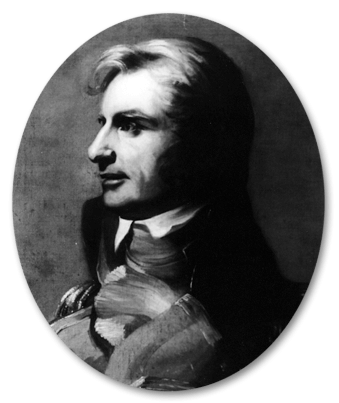As the Royal Navy tightened its blockade of the American coast during 1813, U.S. Navy captains searched for innovative ways to give American warships an advantage against superior numbers. In Boston, Captain Charles Stewart, a life-long tinkerer, conceived of a portable furnace capable of quickly heating cannonballs to between 1,200 and 1,500 degrees Fahrenheit. The red-hot balls might be fired at a pursuing warship; if they stuck in its timbers, they could quickly ignite dry, tarry, painted wood.

“I have constructed a portable sheet iron furnace for heating red hot shot of the following dimentions [sic] which would answer as well for land service as sea service Lenth [sic] 3 feet depth 3 feet width 18 inches, it heated 21 shot 24 lbs. in 22 minutes with a pine wood fire. The construction of the pipe is such as gives it a great draught. from its dimentions [sic] you can readily conceive it occupies little room, and is calculated to set to the back part of our Galley where it interferes with nothing My purpose is only to use it against the enemys [sic] ships of such force as would render our safety precarious, (if we cannot otherwise escape,) by bringing them under our stern battery and firing a few red hot ball in their hull. They are not very expensive and all our frigates haveing [sic] them, the use of which might facilitate their escape from a superior force by the confusion they would be thrown into, if not the destruction of an enemy that is not disposed to contend with us on fair and equal terms.”1
According to Stewart, nothing could be more effective at extricating a ship from a tight spot than a few hot shot fired from the ship’s stern chasers. His idea was not wholly original. Shore batteries often employed this tactic during the period, but the process was generally considered too dangerous for shipboard use. The problems of heating and transporting super-heated shot from furnace to gun, and then loading the gun without the powder charge going off prematurely, speak for themselves. Nevertheless, Secretary Jones seemed intrigued by the idea, and 20 days later Stewart forwarded a model of his invention to Washington:
“Herewith you will receive a model of the furnace for heating red hot shots The fronts [sic] of tin are to be made of thick sheat [sic] iron riveted together as the dots represent, the grates of strong bar iron which is represented by wood, the pan of tin goes under to received the ashes and coals that fall. the construction of the drauft [sic] pipe is the most important.
This model is made on a scale of one and a half inches to the foot and represents exactly the one made for the Ship. The shot is placed on the upper grate and the fire wood on the lower. they are verry [sic] portable and would answer for Gunboats.”2
By this point, the full-scale prototype had already been installed on board USS Constitution. On December 18, Navy Agent Amos Binney paid $294.34 to George Darracott of Boston. The bill enumerates the items purchased: “1 Furnace for heating Shot 467lbs,” “Grates and Frame,” “1 p[ai]r Shot Tongs,” “1 Shot Ladle,” and “30 lbs Sheet Iron.”3
How did the crew use this apparatus? Typically a furnace needed at least two men to run it. One stoked the fire while the other added balls. They coaxed a red-hot shot out of the furnace with the iron tongs, and used the shot ladle to carry it to a gun. The men performed this operation in haste, so that the ball did not cool off before it was loaded in the gun. Yet, loading a red-hot iron ball on top of a powder charge contained in a flannel bag was a delicate operation. Generally, cartridges were double-bagged to prevent loose powder from straying into the bore during the loading process. Once the gun crew rammed home the cartridge, they seated a wet wad, consisting of loosely bundled junk (picked-apart rope), on top. The wad formed a barrier between the cartridge and the ball. The gun crew rammed down the ball, rammed another wad on top, and in quick succession ran out the gun, pointed, and fired. With luck, the shot lodged in the timbers of an enemy ship where its crew could not get to it, and set the ship on fire.
So far, we’ve never found evidence of Constitution or other American ships using the furnaces in combat. The British were well aware of them, however. A Dutch informant in New London, Connecticut told Captain Nash of HMS Saturn that it was “generally understood in the United States all the American Ships of War are now fitted with furnaces for heating Shot; and…the same person knows it to be the case with the Frigate Constitution.”4
1 Charles Stewart to SecNav, 5 December 5, 1813, Captains Letters to the Secretary of the Navy, M125, Roll 33.
2 Charles Stewart to SecNav, December 25, 1813, Captains Letters to the Secretary of the Navy, M125, Roll 33.
3 George Daracott voucher, December 18, 1813, in Amos Binney Settled Accounts, 4th Auditor of the Treasury Alphabetical Series, RG 217, box 38, NARA.
4 Henry Hotham to Admiral Cochrane, November 14, 1814, F. I. Cochrane Papers, National Library of Scotland, MS2337, fol. 125.
The Author(s)
Matthew Brenckle
Research Historian, USS Constitution Museum
Matthew Brenckle was the Research Historian at the USS Constitution Museum from 2006 to 2016.